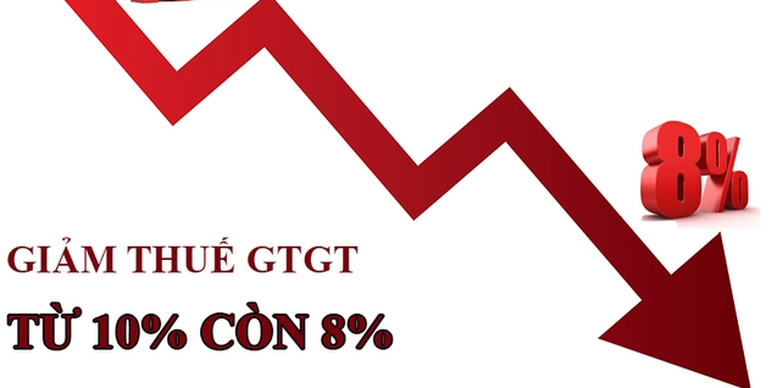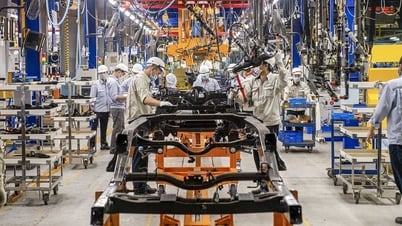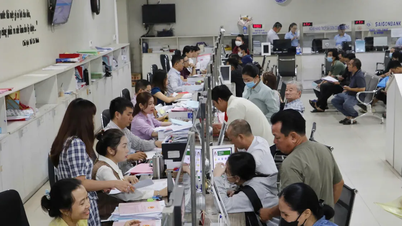State budget revenue will decrease by about 121.74 trillion VND
The proposal to extend and expand the VAT reduction policy is based on clear political and practical grounds. The Government emphasizes that this initiative is consistent with the socio-economic development goals for 2025, which are specified in important documents such as Resolution No. 192/2025/QH15 of the National Assembly, Resolution No. 46/NQ-CP and Resolution No. 77/NQ-CP of the Government. These documents affirm the need for strong measures to achieve high growth and economic restructuring in the 2021-2025 period.
In fact, the VAT reduction policy has proven effective in recent years. From 2022 to the first half of 2025, the 2% reduction in tax rates from 10% to 8% for some goods and services has significantly reduced production costs, increased business profits and stimulated consumer demand. However, the economy still faces many challenges: high production costs, slow recovery of domestic purchasing power, and new trade barriers, such as reciprocal tariffs imposed by the United States on Vietnamese exports. Continuing to reduce VAT and expanding the beneficiaries is expected to strengthen domestic consumption, an important driving force for growth, while supporting the manufacturing, tourism and retail sectors.
This draft Resolution makes notable changes compared to previous tax reduction policies. The policy focuses on reducing the VAT rate from 10% to 8% for goods and services subject to a 10% tax, with an expanded scope including essential products for production, tourism and domestic consumption. Beneficiaries include information technology services, prefabricated metal products, refined petroleum, chemicals, coal (in import and commercial trading), along with gasoline and oil. However, some groups of goods and services are still excluded, including telecommunications, finance, banking, securities, insurance, real estate business, mineral resources (except coal) and items subject to special consumption tax, except gasoline.
In terms of finance, the Government expects the state budget to reduce revenue by about VND121.74 trillion, of which VND39.54 trillion will be in the last 6 months of 2025 and VND82.2 trillion in 2026. However, this policy is expected to bring significant economic benefits. Reducing the cost of goods and services will increase people's ability to pay, stimulate domestic demand and create more jobs. For businesses, reduced production costs will help lower product prices and improve competitiveness in the market. These impacts are expected to contribute to stabilizing the macro economy and supporting Vietnam's growth target in 2025 and the following years.
Balancing economic stimulus and fiscal stability
In the preliminary review report on the Resolution Project to reduce VAT rate by 2% proposed by the Government, the Standing Committee of the National Assembly's Economic and Financial Committee said that this policy is expected to support businesses, stimulate consumption and promote economic growth to reach the target of 8% in 2025. However, the review report also highlighted concerns about the impact on the state budget and the stability of the tax system.
The Standing Committee of the Economic and Financial Committee highly appreciated the necessity of issuing a Resolution on VAT reduction in the context of the domestic economy facing many difficulties, from high production costs, slow recovery of purchasing power, to unstable fluctuations of the global economy affecting export targets. This policy is considered an important solution to promote domestic consumption, support production and business enterprises and contribute to stabilizing the macro economy. Reducing the tax rate from 10% to 8% for goods and services subject to 10% tax (except for fields such as telecommunications, finance, real estate, non-coal mining and goods subject to special consumption tax except gasoline) is expected to reduce product costs, increase competitiveness and create growth momentum.
However, some opinions in the Committee expressed concerns that the policy's stimulus effect may have become saturated after a long period of application since 2022. Continuously extending this policy risks reducing the stability and consistency of the tax system, especially when the Law on VAT (amended) has just been passed by the National Assembly and will take effect from July 1, 2025. Moreover, the estimated reduction in budget revenue of VND 39.54 trillion in the second half of 2025 and VND 82.2 trillion in 2026, while not yet included in the 2025 budget estimate according to Resolution No. 159/2024/QH15, may put pressure on the revenue-expenditure balance and budget deficit. These opinions emphasized that the narrowing fiscal space will limit the ability to respond to more serious economic crises in the future.
Regarding the form of issuance, the Standing Committee of the Economic and Financial Committee largely agreed with the Government's proposal to issue a separate Resolution to reduce VAT, instead of integrating it into the General Resolution of the session as before. The reason is that this time the policy has a longer application period (18 months) and a wider scope, including products such as information technology, prefabricated metals, refined petroleum, chemicals, coal and gasoline. Issuing a separate Resolution is considered appropriate to ensure legality, especially when the content of tax rate reduction conflicts with the Law on VAT (amended), making this Resolution possible to be considered as a pilot policy. However, the Committee noted that the name of the Resolution needs to be carefully considered to comply with the provisions of the Law on Promulgation of Legal Documents.
Regarding the scope of application, the Committee assessed that expanding the tax reduction subjects is necessary to support businesses and promote growth in the difficult economic context. However, some cautious opinions said that this expansion is not really suitable when the economy is growing steadily, and the industries proposed for tax reduction (such as petroleum, chemicals) have had good growth rates and are less affected by the recession. The Committee suggested that the Government more carefully assess the impact on budget revenue, ensure that this policy is associated with the goal of medium-term fiscal stability and public debt safety, and at the same time overcome difficulties in implementation due to the fact that there are still groups of goods and services that are excluded.
The Standing Committee of the Economic and Financial Committee basically supported the Government's proposal but emphasized that the Government needs to absorb the opinions of the reviewers, complete the draft Resolution and take responsibility for ensuring the budget collection task within the budget deficit approved by the National Assembly. In the challenging economic context, balancing between stimulating growth and maintaining fiscal stability will be a problem that requires careful calculation and effective implementation from the Government.
Source: https://thoibaonganhang.vn/de-xuat-giam-thue-gtgt-de-thuc-day-tang-truong-kinh-te-giai-doan-2025-2026-163222.html






![[Photo] Top players gather at the 2025 Nhan Dan Newspaper National Table Tennis Championship](https://vphoto.vietnam.vn/thumb/1200x675/vietnam/resource/IMAGE/2025/5/23/9ad5f6f4faf146b08335e5c446edb107)












































































![[E-Magazine] - Sparkling lotus love](https://vphoto.vietnam.vn/thumb/402x226/vietnam/resource/IMAGE/2025/5/23/a88277aeff0f4dfb9047554fb1139760)













Comment (0)